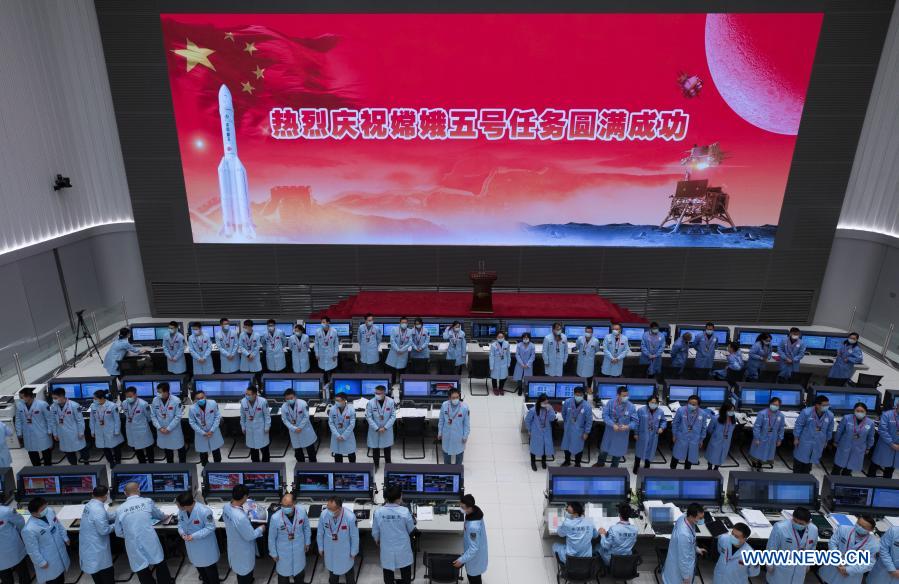
While the landing of China’s Chang’e-5 spacecraft on the moon earlier this month was a significant event on humanity’s collective journey through space, the planting of a Chinese flag on the lunar surface raises serious concerns about the extension of national laws to other celestial bodies.
As Beijing has increasingly sought to extend its laws beyond its borders, it may seek to use the flag-planting to justify the extension of its jurisdiction to activities on the lunar surface.
On 1 December, the Chang’e-5 probe touched down near Mons Rümker in the moon’s Oceanus Procellarum region, an area characterised by a high volcanic complex, and some distance from the US Apollo mission sites. The craft collected rock and dirt samples before lifting off on 3 December. A capsule holding the samples was delivered safely to earth on 17 December.
The probe’s successful landing was well received by the international community, with scientists optimistic that the mission would contribute to a greater understanding of the moon’s history. NASA’s science mission chief, Thomas Zurbuchen, tweeted a hope that ‘everyone will benefit from being able to study this precious cargo that could advance the international science community’.
On 4 December, the China National Space Administration released images showing the national flag unfurled on the moon, the first flag planted on the lunar surface since the Apollo 17 mission. Images of the flag-planting were disseminated widely across Chinese state media channels Xinhua and CGTN. News reports focused on the flag’s ‘genuine fabric’ materials, designed to withstand all manner of lunar conditions, and explained that it was a reminder of the ‘excitement and inspiration’ felt during the Apollo missions.
However, while the flag-planting may have been overlooked or dismissed by international observers as a purely symbolic gesture without legal consequences, the reality is more nuanced. Beyond the Chang’e-5 mission’s stated intent to further scientific progress, the placing of the Chinese flag on the moon bears significant national importance for Beijing, carries heavy political overtones and elicits various concerns under international law.
Historically, the planting of flags by nations and colonial powers has been often associated with the declaration of sovereignty, involving an assertion of title over territory based on acts of discovery. Six American flags were planted during the Apollo missions across their landing sites, though the US later clarified its intentions in a law passed by Congress, describing the flag-planting as ‘a symbolic gesture of national pride in achievement’.
In Beijing’s previous attempts to apply domestic national security laws extraterritorially, the protection of China’s national flag in all circumstances has been central. On 2 October, after pro-Hong Kong protestors burned the Chinese flag outside Beijing’s embassy in London, Chinese officials issued a statement saying that this action amounted to desecration and violated China’s 1990 Flag Law and the 2020 Hong Kong National Security Law. They urged UK officials to investigate and prosecute those responsible.
Protection of the flag is a national security matter under China’s flag law and any attempt to deface or tarnish the national flag is illegal. In the US, in contrast, legal precedent set in 1989 holds that desecration of the American flag is a protected form of free speech under the constitution, despite its being codified as an offence under US law.
China’s extraterritorial reach under Article 38 has been one of the Hong Kong security law’s defining features. The law applies to offences committed against Hong Kong ‘from outside the Region by a person who is not a permanent resident of the Region’. While this sparked derision over the absurdity and infeasibility of the law being applicable anywhere on earth, it did not stop Beijing from charging American citizens residing in the US under the law. However, as opposed to the noncorporeal imposition of the security law, the flag represents a stronger case for extraterritorial enforcement as a physical object and extension of Chinese jurisdiction.
The flag-planting therefore reinforces the extraterritorial extension of Chinese law on the lunar surface in two ways. First, because treatment of the flag is tied to national security, any attempt to remove it or disturb its environment by future astronauts may be construed as desecration. Second, Beijing’s actions symbolically constitute the creation of a ‘lunar safety zone’, denoting the exercise of de facto ownership of the area around an object. This would undercut Washington’s designs to establish safety zones on the moon in the near future, as outlined under the recent Artemis Accords.
Article 2 of the 1967 Outer Space Treaty prohibits any country from claiming territory on the moon through an assertion of sovereignty or any other means. Under international law, therefore, China cannot use the flag-planting to claim sovereignty over any part of the moon. However, Beijing may seek to emulate Washington’s legal reasoning under the accords, arguing that establishing safe zones around its flag doesn’t constitute static borders, but rather an incorporation of environmental factors and circumstances pertinent to the flag’s continuing condition.
China’s calculated decision to plant its national flag on the moon could well be the start of further escalation in the ongoing competition between Washington and Beijing in outer space. It is to be hoped that both sides continue to abide by the international rules-based order laid down by the Outer Space Treaty and respect the continued exploration and use of outer space as the province of all mankind.

